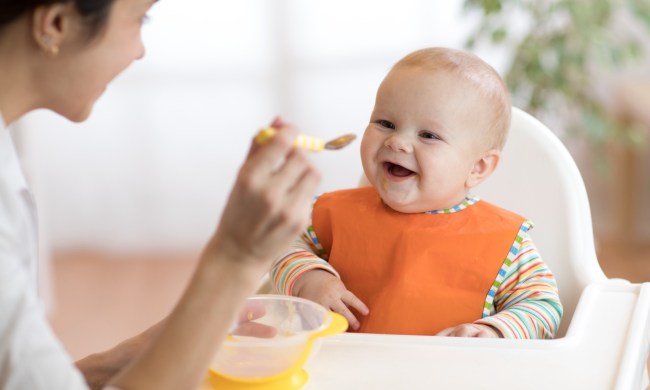Is there anything better than cuddling with your baby or small child? You know that one day, they won’t need you as much, making it easier to handle being nap-trapped. That sweet face, at ease, nestled in your lap or on your chest, is irresistible, and time slows down.
Some parents take this concept even further by raising their children using “attachment parenting.” What is attachment parenting? In short, it focuses on remaining close to the child and responding to their needs, including at night (sleep training is a no-go under an attachment parenting philosophy).
Many people often misunderstand and confuse this method with other strategies, like gentle parenting. It’s also not for everyone, and there’s no need to feel guilty if it doesn’t work for your family. However, understanding different parenting methods can help you pick what works best for you. Here’s a primer on attachment parenting.

What is attachment parenting?
Attachment parenting is a method developed by pediatrician William Sears and registered nurse Martha Sears. The approach involves staying close to your child and responding to their needs. The idea is this method will have a long-term effect on a child’s emotional development and relationships. Sears believes there are “seven B’s.” According to Sears:
- Birth bonding: The period from immediately after birth and through the first six weeks is crucial for bonding.
- Breastfeeding. Breast/chestfeeding is a nutritious way to feed and comfort a baby. The closeness promotes a bond between the lactating parent and the child.
- Babywearing. Putting the baby in a carrier or sling encourages skin-to-skin contact and a loving connection.
- Bedding close to baby. Room or bed sharing allows parents and babies to get a good night’s sleep and parents to respond quickly to the little one’s needs.
- Belief in the language value of your baby’s cry. Babies cry for a reason, and parents should answer these cries.
- Beware of baby trainers. Sears believes adhering to a schedule, such as interval feedings and strict sleep-wake windows, is “convenience parenting.” He advocates for responding to a baby’s cues.
- Balance. Parenting can be challenging and all-consuming. Sears advises parents to take time to focus on themselves and their relationships.
It’s essential to remember a few points: Adoptive and foster parents can have strong bonds with children even if they don’t meet them for the first six weeks. Human milk is the biologically normal food for a human infant and child, but the first rule is to feed the baby. Not everyone wants to breastfeed, and a small number of birthing parents cannot. These parents will still bond with their children.
The American Academy of Pediatrics (AAP) warns against bed sharing, citing the risk of infant death. However, other organizations, like La Leche League, promote safe bed sharing through the Safe Sleep Seven. Sleep decisions are highly personal to each family.

What’s the difference between gentle parenting and attachment parenting?
Some similarities between gentle and attachment parenting exist, and some parents use both styles. Both involve responding to a child’s needs. However, gentle parenting is less about constant contact and more about developing respect, empathy, and discipline. Instead of yelling at a child for melting down, a parent would say, “I hear you’re upset that we’re not having cookies tonight. We’ll have some tomorrow, and I can’t wait. For now, it’s OK to be upset. It’s tough not getting what you want. I’m here if you want a hug or tissue.”

What are the pros and cons of attachment parenting?
Purported benefits of attachment parenting include:
- Stronger bond between parent and child
- Language development
- Physically healthier children from breastfeeding
- Higher emotional IQs in children
- Better emotional regulation
What does the science say?
The most research-backed aspect of attachment parenting surrounds breast/chestfeeding. The AAP updated its feeding guidance to encourage feeding a child human milk for at least two years if it works for the family. The AAP cited numerous studies showing benefits for both the lactating parent and the child, including the risk of diabetes and some cancers. Of course, children thrive on formula, too.
A 2019 meta-analysis said children of attachment parenting had better language skills. Research from 2010 found that children raised under the attachment parenting ethos cried less. There is no conclusive research to back the idea that attachment parenting is superior to any other style. Attachment parenting isn’t feasible for every family. For example, the United States does not have federally paid family leave. About 25% of new mothers return to work within two weeks of giving birth.
Some parents may also feel tethered by the idea of having a child on them constantly. Others may not feel comfortable with the sleep arrangements Sears prescribes. If these concerns negatively affect your bond with your child, attachment parenting may not be for you.

How to incorporate attachment parenting realistically
You may not want to use every aspect of attachment parenting, but perhaps the idea of keeping your baby close appeals to you. It’s OK to take and leave some of the advice. It’s your family and parenting style.
- Baby wear. Putting your child in a sling or carrier is a hands-free way to sneak in extra cuddles.
- Give breastfeeding a go (if you’re interested). It’s a beautiful experience if it works out and provides long-term benefits for the baby and lactating parent. An IBCLC can help support you in reaching your goals.
- Room share. Keeping a child in a separate space in your room allows you to quickly grab them for night feedings or if they’re in distress.
- Take balance to heart. Have a date night with your partner, even if it means watching a favorite old movie together at home after the baby has gone to bed.
Attachment parenting involves staying close to and responding to your child. Some evidence shows it may help with emotional regulation and language development. By and large, there is no evidence to support it being “better” than any other style of parenting. That’s excellent news. Why? Because if attachment parenting works for you, that’s great. If it doesn’t, that’s fine, too. Want to breastfeed but encourage a ton of floor time and independent play over babywearing all day? Cool. Researching the pros, cons, safety, and health hazards of certain styles of sleep and feeding can help you make the most informed decisions for your family on these aspects of attachment parenting.


